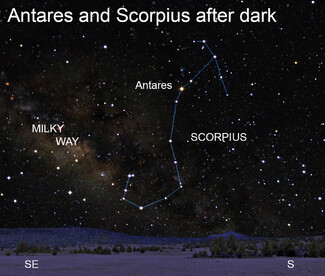My Longtime Celestial Friend
Last updated 9/5/2023 at 12:52pm
Summer is now upon us in the Earth's Northern Hemisphere, and with it comes a changing canopy of stars that always transports me back to childhood.
It was a simpler, more innocent time – a time when neighbors sat on their porches in the evenings, there was no school for at least several months, and ice cream or watermelon was all we ever needed to stay cool. Life seemed just about as good as it could be.
And it was on nights like these that I recall lying back on the cool grass of my backyard watching my favorite star, Antares. Its ruddy light always twinkled through the summertime haze that seemed to hang in the southern sky over the Coursens' house.
What warm and comforting memories these are from such a magical time of discovery.
Though life has changed much for me since those halcyon days, Antares remains a wonderful friend. Even today, wherever I find myself on our huge planet, as Antares appears in the sky after dark, I get a huge smile on my face as I joyfully greet my nearest celestial childhood friend and reminisce about the wonderful times we've spent together.
That's the power of making friends with the stars.
Antares played a prominent role in not only my life, but also the lives of many in early cultures. For example, in about 3000 B.C., Antares was considered one of the four "royal stars" of ancient Persia; some suggest it may have been the "lance star" referred to in the biblical Book of Job. Even the ancient Egyptians aligned temples with this star to make it part of their ceremonies.
Today, of course, we recognize Antares as a red supergiant that is nearing the end of its stellar life. This star is so immense that if brought to our Solar system to replace our sun, the star's atmosphere would engulf the orbits of Mercury, Venus, Earth and Mars and would extend halfway to Jupiter. It lies so distant that the light we see tonight has been traveling through space for more than half a millennium.
In other words, if stargazers on a planet orbiting this aging star had a telescope powerful enough to monitor activity on our world some 550 light-years distant, they would now be watching the early decades of the Italian Renaissance ... in real time. Now how cool is that!
To me, it's these tiny bits of information that help make Antares even more "personable."
This remarkable star marks the heart of the celestial arachnid known as Scorpius, the scorpion, one of the most recognizable constellations in all the heavens. Look for it this week rising in the south-southeastern sky after dark. You'll have little trouble finding it; several stars outline its claws at the top, and a long curving stellar arc traces its tail and, at its very tip, its stinger.
Yes, summertime is finally here. What a marvelous time of year to leave behind your mundane worries, travel to a dark location at night, lie on the grass and make friends with the stars.
And if you do, be sure to give Antares a warm smile for me!
Visit Dennis Mammana at dennismammana.com.




